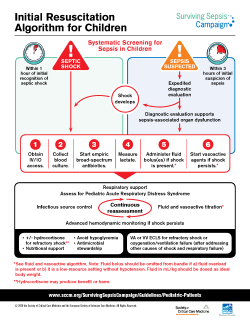Initial Resuscitation Algorithm for Children
Use this algorithm to implement recommendations from the Surviving Sepsis Campaign’s children’s guidelines. It provides a guide for systematic screening for sepsis in children and guidance for care in settings both with and without intensive care services.
The following organizations have endorsed this algorithm:
- American Academy of Pediatrics (AAP)
- American Association of Critical-Care Nurses (AACN)
- American College of Emergency Physicians (ACEP)
- American College of Chest Physicians (CHEST)
- Pediatric Infectious Diseases Society (PIDS)
- Scandinavian Society of Anaesthesia and Intensive Care Medicine (SSAI)
- Society of Infectious Diseases Pharmacists (SIDP)
- UK Sepsis Trust
- World Federation of Pediatric Intensive and Critical Care Societies (WFPICCS)
